History of bras
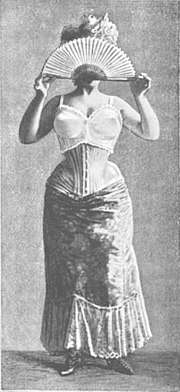
The history of bras is inextricably intertwined with the social history of the status of women, including the evolution of fashion and changing views of the female body.
Women have used a variety of garments and devices to cover, restrain, reveal, or modify the appearance of breasts. Bra- or bikini-like garments are depicted in some female athletes of the Minoan civilization in the 14th century BC.[1] From the 14th century onward, the undergarments of wealthier women in the Western world were dominated by the corset, which supported the breasts by transferring their weight to the rib cage. Corsets varied in length from short ones which only supported the bust to longer ones also used to shape the waist. In the latter part of the 19th century, women experimented with various alternatives such as splitting the corset into a girdle-like restraining device for the lower torso and transferring the upper part to devices suspended from the shoulder.[2]
In the late 19th century, bras replaced the corset as the most widely used means of breast support.
By the early 20th century, garments more closely resembling contemporary bras had emerged, although large-scale commercial production did not occur until the 1930s. Since then bras have replaced corsets (although some women prefer camisoles) and some, as well, go without.[3] The metal shortages of World War II encouraged the end of the corset. By the time the war ended, most fashion-conscious women in Europe and North America were wearing bras. From there the bra was adopted by women in Asia, Africa, and Latin America,[4] although we have no information about what arrangements, if any, immediately preceded the adoption of the bra across Asia, Africa and Latin American .
During the 20th century, greater emphasis has been given to the fashion aspects of bras. The manufacture of bras is a multibillion-dollar industry dominated by large multinational corporations.
Ancient
Egypt
In ancient Egypt, women were generally bare breasted. The most common items of female attire were the skirt and the sheath dress, also described as a tunic or kalasiris,[5] a rectangular piece of cloth that was folded once and sewn down the edge to make a tube. The kalasiris might cover one or both shoulders or be worn with shoulder straps. While the top could reach anywhere from below the breast to the neck, the bottom hem generally touched the ankles. A variant was a single cross strap, partially over the left breast. The shorter kalasiris was mostly worn by common women or slaves, to be more comfortable when working.
India
Although the majority of female figures in ancient Indian sculptures are devoid of a blouse, there are several instances of ancient Indian women wearing bras. The first historical reference to bras in India is found during the rule of King Harshavardhana (1st century AD). Sewn bras and blouses were very much in vogue during the Vijayanagara empire and the cities brimmed with tailors who specialized in tight fitting of these garments. The half-sleeved tight bodice or kanchuka figures prominently in the literature of the period, especially Basavapurana (1237 AD), which says kanchukas were worn by young girls as well.[6]
Greece

Wearing a specialized garment designed to restrain a woman's breasts may date back to ancient Greece. Wall paintings in Crete, the center of the Minoan civilization, show a woman performing athletics in what has been described as a "bikini". Minoan women on the island of Crete 3,000 years ago apparently wore garments that partially supported and also revealed their breasts; the best known example of this style is the Snake Goddess. Their clothing looked somewhat like modern fitted and laced corsets or a corselette. The support device was worn outside other clothing and supported and exposed the breasts, pushing them upwards and making them more visible. The succeeding Mycenae civilization emphasized the breast, which had a special cultural and religious significance, associating the mature figure with fertility and procreation.[7]
Women in Classical Greece[8] are often depicted loosely draped in diaphanous garments, or with one breast exposed. Women wore an apodesmos (Greek: ἀπόδεσμος,[9] later stethodesmē (Gr: στηθοδέσμη[10]), mastodesmos (Gr: μαστόδεσμος[11]) and mastodeton (Gr: μαστόδετον[12]), all meaning "breast-band", a band of wool or linen that was wrapped across the breasts and tied or pinned at the back.[13][14]
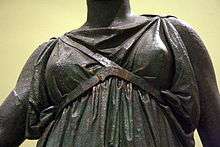
A belt could also be fastened over a simple tunic-like garment or undergarment, just below the breasts or over the breasts. When the apodesmos was worn under the breasts, it accentuated them. Another word for a breast-band or belt was strophion (Gr: στρόφιον).[15][16][17] A further term was kestós (Gr: κεστός, Latin: cestus), used specifically for Aphrodite's charmed girdle in the Iliad,[18] whose power was to make every woman who wore it irresistible to men. In view of its association with the love goddess, this type of garment probably had an erotic connotation because of its effect to accentuate the breast.[19][20]
The basic item of classical Greek costume was the peplos, later the chiton (two rectangular pieces of cloth partially sewn together on both sides, with a 30 to 38 centimetres (12 to 15 in) overfold or apoptygma), which evolved into the chemise, the most common item of underclothing worn by men and women for hundreds of years (also variously known as a smock or shift). In Sparta, women usually wore the chiton completely open on the left side.
Rome

Women in ancient Rome adopted a form of the Greek apodesme, known as the strophium or mamillare. Since the Romans regarded large breasts as comical, or characteristic of aging or unattractive women,[21] young girls wore breast bands (fascia) secured tightly in the belief that doing so would prevent overly large, sagging breasts.[22]
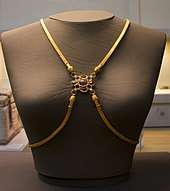
The so-called "bikini girls" mosaic from the Villa Romana del Casale (4th century AD) shows women performing gymnastic or dance routines while wearing a garment similar to a strapless bra and briefs.[23][24] Other primitive iterations of a bra are depicted earlier in wall paintings preserved at Pompeii by the eruption of Vesuvius in 79 AD.[25]
Sometimes in the most sexually explicit Roman paintings, the breasts are kept covered by the strophium. The settings in which the paintings are found indicate that the women depicted may be prostitutes.[26]
East Asia
In China, a loose silk bodice tied at the waist and tied or looped around the neck called the dudou (lit. "belly cover") came into fashion among wealthy women during the Ming dynasty of the 14th–17th centuries.[27] It remained popular under the succeeding Qing dynasty (17th–20th centuries).[28][29][30] It was adopted into Vietnamese culture as the yếm and remains in traditional use among the two cultures.
Middle Ages
In Europe, in the Middle Ages it was exceptional for women to restrict or support their breasts and if they did, they probably used something like a cloth binder, as is suggested in descriptions of the time. A widely quoted statement is that an edict of Strasbourg in the Holy Roman Empire, dated 1370 states, "No woman will support the bust by the disposition of a blouse or by tightened dress." An archeological find circa 1390 to 1485 revealed that women did in fact support their breasts in the Middle Ages. Four lace-decorated bras were found among 3,000 textile fragments during a renovation project in an Austrian castle.[31][32] By the time of Charles VII of France (1403–1461), a gauze drape was used over the bust.
Generally, in the Middle Ages the breasts were minimized in dresses with straight bodices, full skirts and high necklines, designed primarily for function rather than emphasis on form. Late medieval dresses are fitted precisely and snugly to the body and function as breast support. Depictions of women in 14th- and 15th-century art show a high, rounded breast silhouette on women old and young, full-busted and small. This look is not possible without support. The 15th-century ideal form was small-breasted and full-figured, symbolizing abundance of fertility.
By the time of the Renaissance, décolletage became very fashionable. There was some status to firm breasts in upper class women, who did not breast feed. Infants were given to wet nurses to breast feed, since nursing was considered bad if a woman wanted to maintain an ideal form. Among the wealthier classes, the corset was beginning to appear by the mid-15th century.
Catherine de' Medici (1519–1589, wife of King Henry II of France) is widely, and wrongly, blamed for the corset. She was reported to have prohibited wide waists at court in the 1550s, legend suggesting she made them wear steel framework corsets.
Elaborate constraints placed on women's figures over the years were not universal. Corsetry made it virtually impossible to work, so simpler functional garments were worn by women who worked inside or outside the home. Support for the breasts was often provided by a simple tie under the breast line, in the bodice.
Renaissance
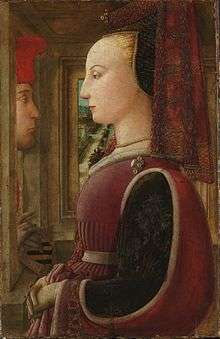
Early corsets of the 16th century consisted of paste-stiffened linen and a primitive busk at the front but later included iron supports at the side and back. The emphasis now was on form, with compression of the breasts forcing them upwards to the point of almost spilling out, so a considerable part of the breast was exposed. The ideal form was a flat torso, which inevitably pushed the breasts upwards and out. The labouring class by contrast wore a simple front-lacing cotte.
During the French Revolution and the Napoleonic Wars, any garment associated with the aristocracy was frowned upon, including those with visible décolletage. The breasts were often supported by a tie below the bust, and extant bust-support garments ranged from soft stays to wrap-front items similar to sports bras. In 1814, the court and the corset returned.
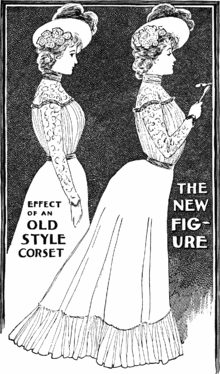
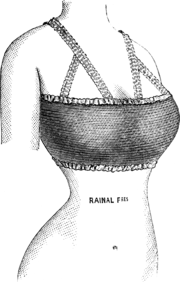
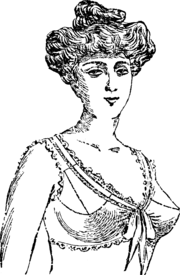
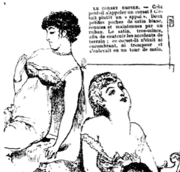
French Empire
Empire fashion originated during the Directoire period, popularized by women such as Joséphine de Beauharnais. "Inspired by the mania for the Graeco-Roman, with its connotations of artistic excellence and political liberty, fashionable women discarded corsets and adopted sleeveless transparent tunics.[33] Embracing the classical silhouette, in Britain this period was known as the Regency. During this era, "fashion-conscious women ... pored over fashion journals like Le Journal des Dames et de la Mode, the era's version of Vogue, in order to see what Josephine was wearing and attempt to copy her style.[34] The most popular chest support in this period were short stays, a type of lightly boned corset.
Victorian era in Britain
In the Victorian era, despite contemporary ideas about morality, women's clothing was paradoxically designed to emphasize both the breasts and hips by tightlacing the waist. Victorian women were encumbered with many layers of clothing, including a chemise with a drawstring neckline, usually drawers, then the corset and corset cover, the under petticoat, the hoop skirt, the over petticoat, and finally the dress. According to the social expectations of the times, even the lowest-cut evening gown should dip no lower than three finger breadths below the clavicles.
Edwardian era in Britain
By the Edwardian era, with some increase in women's physical activities, the corset started to retreat southward again, becoming more like a girdle and accompanied by the appearance of a separate upper garment, the Bust Bodice, or BB. For those who instead wore a one-piece undershift (unionsuit), this separated into the camisole and drawers. These were not designed for support but merely coverage.
Women's dress emphasized an "S" shape, with an indrawn stomach giving prominence to the posterior and bust. In the late 19th century and early 20th century the bosom could still be displayed. "The high-water mark of modesty would ebb after sunset some six inches!"[35] Corsets remained the main form of support, but war and its impact on lifestyle and materials meant that its future was uncertain.
The Clothing Reform Movement
The evolution of the bra from the corset was driven by two parallel movements: health professionals' concerns about the cruel, constraining effects of the corset, and the clothing reform movement of feminists who saw that greater participation of women in society would require emancipation from corsetry. Prominent amongst these were the Rational Dress Society,[36] the National Dress Reform Association,[37] and the Reform Dress Association.[38]
Although there were a number of voices warning about the considerable health risks of corsets, health professions were generally muted, and women ignored "unfashionable" advice. The health professions concentrated more on psychosomatic complaints, which were in fact probably related to corsetry. Ill health was considered synonymous with femininity, and a pale and sickly demeanor was normative. (Fictional heroines often died from tuberculosis, or "consumption." This made them pale and kept them immobile.) Corsets were supposed to provide both physical and moral support.
Some physicians ignored colleagues who felt corsets were a medical necessity because of women's biology and the needs of civilized order. The physicians who raised the alarm pointed to nausea, bowel disturbances, eating disorders, breathlessness, flushing, fainting, and gynecological problems. Bed rest was a common prescription for the "weaker sex," which of course implied relief from corsetry.
Women's interest in sport, particularly bicycling, forced a rethinking, and women's groups called for "emancipation garments." Elizabeth Stuart Phelps urged women to "burn the corsets!" in 1874. Indirectly and directly, sports empowered women in other social climates.
Not surprisingly, corsetieres fought back, embellishing their products to be frilly and feminine in the 1870s. Advertising took on overtones of erotic imagery, even if in practice they acted as a deterrent to sexuality, especially when they started appearing in men's magazines, stressing cleavage and bare arms (then taboo). Dolls assumed the corseted image, implanting an image of the "ideal" female form. Corsets certainly reinforced the image of a weaker sex, unable to defend themselves, and also made it a challenge to disrobe.
In practice, early bras made little market penetration. They were expensive, and only educated wealthy reformers wore them to any extent.[39]
American women who made important contributions included Amelia Bloomer (1818–1894) ("When you find a burden in belief or apparel, cast it off")[40] and Dr. Mary Edwards Walker (1832–1919).
The emergence of the bra in the 19th century
There are considerable differences of opinion as to who "invented" the modern brassière or bra. Patent dates indicate some of the landmark developments; a large number of patents for bra-like devices were granted in the 19th century. However, what is regarded as the world's oldest push-up bra was discovered in storage at the Science Museum in London. Designed to enhance cleavage, the bra is said to be from the early 19th century.[41]
A bra-like device[42] that gave a symmetrical rotundity to the wearer's breasts was patented in 1859 by Henry S. Lesher of Brooklyn, New York. In 1863, a "corset substitute" was patented by Luman L. Chapman of Camden, New Jersey. Historians refer to it as a "proto-bra."[39]
In 1876, dressmaker Olivia Flynt was granted four patents covering the "true Corset" or "Flynt Waist." It was aimed at the larger-breasted woman. Reformers stimulated demand for and probably purchased these early garments on "hygienic" grounds because of their concerns about the corset. Initially Flynt's garments were only available by mail order, but they eventually appeared in department and clothing stores and catalogues. Her designs won a bronze medal at the Massachusetts Charitable Mechanics Association in 1878, at the Cotton Centennial Exposition in Atlanta in 1884–5, and at the Columbian Exposition in Chicago in 1893.[43]:171
According to Life magazine, in 1889 Herminie Cadolle of France invented the first modern bra.[44] It appeared in a corset catalogue as a two-piece undergarment, which she originally called the corselet gorge, and later le bien-être (or "the well-being"). Her garment effectively cut the traditional corset in two: The lower part was a corset for the waist and the upper part supported the breasts with shoulder straps. Her description reads "designed to sustain the bosom and supported by the shoulders." She patented her invention and showed it at the Great Exhibition of 1889. The company, still family-owned, claims today that Herminie "freed women by inventing the first Bra."[45] By 1905, the upper half was sold separately as a soutien-gorge, the name by which bras are still known in France. She also introduced the use of "rubber thread" or elastic.
In 1893, Marie Tucek received a U.S. patent[46] for a device that consisted of separate pockets for each breast above a metal supporting plate and shoulder straps fastened by hook-and-eye. This invention more closely resembled the modern bra known today, and was a precursor to the underwire bra.[47][48]
Home-sewn garments competed with factory-made, ready-to-wear garments. The bra was at first an alternative to the corset, as a negligée or at-home wear, or worn by women with medical issues stemming from corsets. After the straight-fronted corset became fashionable in the early 20th century, a bra or "bust supporter" became a necessity for full-busted women because the straight-fronted corset did not offer as much support and containment as the Victorian styles. Early bras were either wrap-around bodices or boned, close-fitting camisoles (both worn over the corset). They were designed to hold the bust in and down against the corset, which provided upward support.
Advertising of the times, typically in periodicals, stressed the advantages of bras in health and comfort over corsets and portrayed garments with shoulder supports in a mono-bosom style and with limited adaptability. Their major appeal was to those for whom lung function and mobility were priorities, rather than outer appearance.[39]
The 20th century and modern era bra (United States)
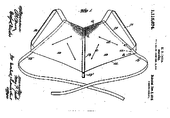
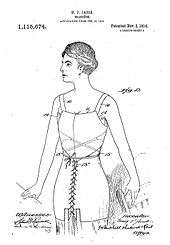
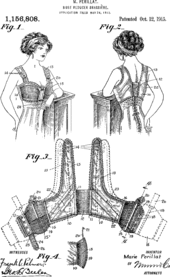
The first modern bra was patented by the German Christine Hardt in 1889. Sigmund Lindauer from Stuttgart-Bad Cannstatt, Germany developed a bra for mass production in 1912 and patented it in 1913. It was mass-produced by Mechanischen Trikotweberei Ludwig Maier und Cie. in Böblingen, Germany. With metal shortages, World War I encouraged the end of the corset. By the time the war ended, most fashion-conscious women in Europe and North America were wearing bras. From there the bra was adopted by women in Asia, Africa, and Latin America.[49]
In 1910, Mary Phelps Jacob (known later in life as Caresse Crosby), a 19-year-old New York socialite, purchased a sheer evening gown for a debutante ball. At that time, the only acceptable undergarment was a corset stiffened with whalebone. Mary had large breasts and found that the whalebone visibly poked out around her plunging neckline and from under the sheer fabric. Dissatisfied with this arrangement, she worked with her maid to fashion two silk handkerchiefs together with some pink ribbon and cord.[50]:7 [51] Her innovation drew immediate attention that evening and, at the request of family and friends, she made more of her new device. When she received a request for one from a stranger, who offered a dollar for her efforts, she realized that her device could turn into a viable business.[50]
On November 3, 1914, the U.S. Patent Office issued the first U.S. patent[52][53][54]:54 for the "Backless Bra." Crosby's patent was for a device that was lightweight, soft, comfortable to wear, and naturally separated the breasts, unlike the corset, which was heavy, stiff, uncomfortable, and had the effect of creating a "monobosom."[55][56]
Crosby managed to secure a few orders from department stores, but her business never took off. Her husband Harry Crosby discouraged her from pursuing the business and persuaded her to close it.[50] She later sold the bra patent to the Warners Brothers Corset Company in Bridgeport, Connecticut, for $1,500 (roughly equivalent to $21,930 in current dollars). Warner manufactured the "Crosby" bra for a while, but it did not become a popular style and eventually was discontinued.[39] Warner went on to earn more than $15 million from the bra patent over the next 30 years.
Bras became more common and widely promoted over the course of the 1910s, aided by the continuing trend towards lighter, shorter corsets that offered increasingly less bust support and containment. In 1917 at the beginning of the U.S. involvement in World War I, the U.S. War Industries Board asked women to stop buying corsets to free up metal for war production. This was said to have saved some 28,000 tons of metal, enough to build two battleships.[57]
It has been said that the bra took off the way it did in large part because of World War I, which shook up gender roles by putting many women to work in factories and uniforms for the first time. The war also influenced social attitudes toward women and helped to liberate them from corsets. But women were already moving into the retail and clerical sectors. Thus the bra emerged from something that was once discreetly tucked into the back pages of women's magazines in the 1890s, to prominent display in department stores such as Sears, Roebuck, and Montgomery Ward by 1918. Advertising was now promoting the shaping of the bust to contemporary fashion demands, and sales reflected this.[39]
The 1920s
As the corset became shorter during the later 1910s, it provided less support to the bust. By 1920 the corset started at the waist, and bust containment yielded entirely to the bra. A low, sloping bustline became more fashionable. Brassieres from the late 1910s and early 1920s were merely slightly shaped bandeaus (bandeaux) style, holding the bust in and down by means of a clip attached to the corset.
This culminated in the "boyish" silhouette of the Flapper era of the 1920s, with little bust definition. The term (which in the mid-1910s referred to preteen and early-teenage girls) was adopted by the J. Walter Thompson advertising agency in the 1920s for their younger adult customers. The androgynous figure then in style downplayed women's natural curves through the use of a bandeau bra, which flattened breasts. It was relatively easy for small-busted women to conform to the flat-chested look of the Flapper era. Women with larger breasts tried products like the popular Symington Side Lacer that, when laced at the sides, pulled and helped to flatten women's chests. Yet some "bras" of the early 1920s were little more than camisoles.
In 1922, Russian immigrant Ida Rosenthal was a seamstress at the small New York City dress shop Enid Frocks. She and her husband William Rosenthal, along with shop owner Enid Bissett, changed the look of women's fashion. They noticed that a bra that fit one woman did not fit another woman with the same bra size. With $4,500 invested in their new business, they developed bras for all ages. Their innovation was designed to make their dresses look better on the wearer by increasing the shaping of the bandeau bra to enhance and support women's breasts. They named the company Maiden Form, a deliberate contrast with the name of a competitor, "Boyishform Company."[39][58] Maiden Form routed Boyishform by 1924, accenting and lifting rather than flattening the bust. In 1927, William Rosenthal, the president of Maiden Form, filed patents for nursing, full-figured, and the first seamed uplift bra.[59]
These fashion changes coincided with health professionals beginning to link breast care and comfort to motherhood and lactation, and campaigned against breast flattening. The emphasis shifted from minimizing the breasts to uplifting and accenting them. Women, especially the younger set, welcomed the bra as a modern garment.
While manufacturing was beginning to become more organized, homemade bras and bandeaux were still quite popular, usually made of white cotton, but they were little more than bust bodices with some separation.
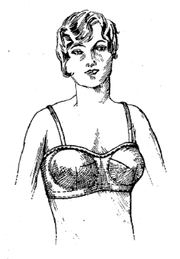
The 1930s
The word "brassiere" was gradually shortened to "bra" in the 1930s. According to a 1934 survey by Harper's Bazaar, "bra" was the most commonly used expression for the garment among college women. The bra was becoming more sophisticated, and home-sewn versions vanished in the 1930s. In October 1932, the S.H. Camp and Company correlated the size and pendulousness of a woman's breasts to letters of the alphabet, A through D. Camp's advertising featured letter-labeled profiles of breasts in the February 1933 issue of Corset and Underwear Review. In 1937, Warner began to feature cup sizing in its products. Two other companies, Model and Fay-Miss, began to offer A, B, C and D cups in the late 1930s. Catalog companies continued to use the designations Small, Medium and Large through the 1940s.[39][60][61]:101 Adjustable bands were introduced using multiple eye and hook positions in the 1930s.
As with other women's products, consumer adoption was encouraged by successful advertising and marketing campaigns. Saleswomen played a key role, helping clients find the right garment, as did the changing role of women in society. Much of this marketing was aimed at young women.
Bras rapidly became a major industry over the 1930s, with improvements in fiber technology, fabrics, colours, patterns, and options, and did much better than the retail industry in general. Innovations included Warners' use of elastic, the adjustable strap, the sized cup, and padded bras for smaller-breasted women. In the US production moved outside of New York and Chicago, and advertising started to exploit Hollywood glamour and become more specialised. Department stores developed fitting areas, and customers, stores and manufacturers all benefited. Manufacturers even arranged fitting training courses for saleswomen. International sales started to form an increasing part of the U.S. bra manufacturer's market. Prices started to make bras available to a wider market, and home-made competition dwindled. Other major manufacturers of the 1930s included Triumph, Maidenform, Gossard, (Courtaulds), Spirella, Spencer, Twilfit, and Symington.
The culturally preferred silhouette among Western women during the 1930s was a pointy bust, which further increased demand for a forming garment.

The 1940s
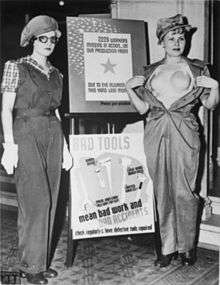
The Second World War had a major impact on clothing. In the United States, military women were enlisted for the first time in the lower ranks and were fitted with uniform underwear. Willson Goggles, a Pennsylvania firm that manufactured safety equipment for manual workers, is believed to have introduced the plastic "SAF-T-BRA", designed to protect women on the factory floor.[62] Advertising appealed to both patriotism and the concept that bras and girdles were somehow "protection". Dress codes appeared – for example, Lockheed informed their workers that bras must be worn because of "good taste, anatomical support, and morale".
Military terminology crept into product marketing, as represented by the highly structured, conically pointed Torpedo or Bullet bra, designed for "maximum projection". The bullet bra was worn by the Sweater Girl, a busty and wholesome "girl next door" whose tight-fitting outergarments accentuated her artificially enhanced curves. Underwire began to be used in bra construction. Actresses like Jane Russell appeared in photographs wearing the new bras that emphasized the "lift and separate" design, which influenced later bra design. For the movie, The Outlaw, which features actress Jane Russell, the producer and airplane designer Howard Hughes constructed the Cantilever bra for Russell to wear in the movie.[63] Hughes constructed the bra so that it would fit and support Jane Russell's breasts. Hughes created the bra on the basis of bridge building. After seeing Jane Russell and her bust in the movie, women sought to recreate the look on their own chests.
The war presented unique challenges for industry. Women's occupations shifted dramatically, with far more employed outside the home and in industry. Severe material shortages limited design choices. Advertising, promotion, and consumerism were limited but started to appear directed at minorities (e.g., Ebony in 1945) and teens. Many manufacturers only survived by making tents and parachutes in addition to bras. American industry was now freed from European influences, particularly French, and it became more distinctive. Again there was concern about the use of badly needed steel in corsets and the British Government carried out a survey of women's usage of underwear in 1941. This showed that "on average, women owned 1.2 bras (housewives 0.8 and agricultural workers 1.9)". [64]
The 1950s
Following the Second World War, material availability, production and marketing, and demand for a greater variety of consumer goods, including bras. The baby boom specifically created a demand for maternity and nursing bras, and television provided new promotional opportunities. Manufacturers responded with new fabrics, colours, patterns, styles, padding and elasticity. Hollywood fashion and glamour influenced women's fashion choices including bras like the cone-shaped, spiral-stitched bullet bra popularized by actresses like Patti Page, Marilyn Monroe, and Lana Turner, who was nicknamed the "Sweater Girl".[65] Bullet bras allowed women to add a cup size to their bust.
Bras for pre-teen and girls entering puberty were first marketed during the 1950s.[66] Prior to the introduction of training bras, young girls in Western countries usually wore a one-piece "waist" or camisole without cups or darts.
The 1960s
The 1960s reflected increasing interest in quality and fashion. Maternity and mastectomy bras began to find a new respectability, and the increasing use of washing machines created a need for products that were more durable. While girdles gave way to pantyhose, the bra continued to evolve. Marketing campaigns like those for the "Snoozable" and "Sweet Dreams" [67] promoted wearing a bra 24 hours a day.
In 1968 at the feminist Miss America protest, protestors symbolically threw a number of feminine products into a "Freedom Trash Can." These included bras,[68] which were among items the protestors called "instruments of female torture"[69] and accouterments of what they perceived to be enforced femininity. A local news story in the Atlantic City Press erroneously reported that "the bras, girdles, falsies, curlers, and copies of popular women's magazines burned in the 'Freedom Trash Can'".[70][71] Individuals who were present said that no one burned a bra nor did anyone take off her bra.[72][73]:4 However, a female reporter (Lindsy Van Gelder) covering the protest drew an analogy between the feminist protesters and Vietnam War protesters who burned their draft cards, and the parallel between protesters burning their draft cards and women burning their bras was encouraged by some organizers including Robin Morgan. "The media picked up on the bra part," Carol Hanisch said later. "I often say that if they had called us 'girdle burners,' every woman in America would have run to join us."[74][72]
Feminism and "bra-burning" became linked in popular culture.[75][76] The analogous term "jockstrap-burning" has since been coined as a reference to masculism. [77] While feminist women did not literally burn their bras, some stopped wearing them in protest.[78][79] Author and feminist Bonnie J. Dow has suggested that the association between feminism and bra-burning was encouraged by individuals who opposed the feminist movement. "Bra-burning" created an image that women weren't really seeking freedom from sexism, but were attempting to assert themselves as sexual beings. This might lead individuals to believe, as she wrote in her 2003 article "Feminism, Miss America, and Media Mythology," that the women were merely trying to be "trendy, and to attract men."[80][81][82][83][84] Women associated with an act like symbolically burning their bra may be seen by some as law-breaking radicals, eager to shock the public. This view may have supported the efforts of opponents to feminism and their desire to invalidate the movement.[85] Some feminist activists believe that anti-feminists use the bra burning myth and the subject of going braless to trivialize what the protesters were trying to accomplish at the feminist 1968 Miss America protest and the feminist movement in general.[86][87][88]
Swimsuit and bra designs
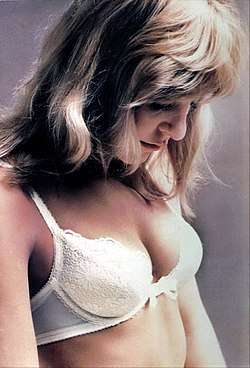
On June 4, 1962, Rudy Gernreich's single-piece, topless monokini swimsuit received worldwide media attention.[89][90] In its December 1962 issue, Sports Illustrated remarked, "He has turned the dancer's leotard into a swimsuit that frees the body. In the process, he has ripped out the boning and wiring that made American swimsuits seagoing corsets."[91]
Gernreich followed that in October 1964 with the "No Bra", a soft-cup, light-weight, seamless, sheer nylon and elastic tricot bra in sizes 32 to 36, A and B cups, manufactured by Exquisite Form. His minimalist bra was a revolutionary departure from the heavy, torpedo-shaped bras of the 1950s, initiating a trend toward more natural shapes and soft, sheer fabrics.[92][93] He also designed an "All-in-None" design with a deep, plunging front, and a "No-Back" long-line version, which featured a contoured stretch-waistband that allowed a woman to wear a backless dress.[94]
The Wonderbra was created in 1964 by Louise Poirier for Canadelle, a Canadian lingerie company. It has 54 design elements that lift and support the bustline while creating a deep plunge and push-together effect. First-year sales for the Wonderbra were approximated at US$120 million.[95] They repositioned Wonderbra as a romantic, fashionable and sexy brand.[96]
The 1970s
Germaine Greer's book The Female Eunuch (1970) became associated with the anti-bra movement because she pointed out how restrictive and uncomfortable a bra could be. "Bras are a ludicrous invention", she wrote, "but if you make bralessness a rule, you're just subjecting yourself to yet another repression."[97]
In the 1970s, like other garment makers, bra manufacturers moved production offshore. The evolution of the bra reflects the constantly changing idea of what an "ideal" woman should look like – flat, round, pointy, conical, or even "natural". The contemporary bra also reflects advances in manufacturing and availability of fabric types and colours, enabling it to be transformed from a utilitarian item to a fashion statement, countering the negative attitudes some women had about bras. Designers have also incorporated numerous devices to produce varying shapes, cleavage, and to give women bras they could wear with open-back dresses, off-the-shoulder dresses, plunging necklines, and the like.
The 1980s
Throughout the 1980s fashion led the way in the look and feel of bras. Western TV shows featured classy, powerful, and well-formed ladies, usually donning low cut tops to show an enhanced chest with an equally classy matching bra.
The onset of classy and stylish Teddy suits also encompassed this decade and sales of silicone increased the need for bigger and more supportive bras.
Models and celebrities all donned fashionable and extravagant bras, showing these off at red carpets events become the norm. [98]
In contrast, feminist Susan Brownmiller in her book Femininity (1984) took the position that women without bras shock and anger men because men "implicitly think that they own breasts and that only they should remove bras."[99]
The 1990s
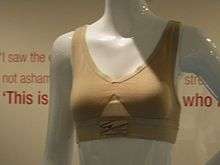
Manufacturers' marketing and advertising often appeals to fashion and image over fit, comfort and function.[100][101] Since about 1994, manufacturers have re-focused their advertising, moving from advertising functional bras that emphasize support and foundation, to selling lingerie that emphasize fashion while sacrificing basic fit and function, like linings under scratchy lace.[102]
With the growing popularity of jogging and other forms of exercise, it became apparent that there was a need for an athletic garment for women's breasts. In 1977, Lisa Lindahl, Polly Smith and Hinda Mille invented the first sports bra[103] in the costume shop of Royall Tyler Theatre at the University of Vermont. One of the original Jogbras is bronzed and on display near the costume shop of the theatre. Two others are housed by the Smithsonian and another by the New York Metropolitan Museum of Art.[104]
The 2000s
Two design challenges that bra manufacturers face at present seem paradoxical. On the one hand, there is a demand for minimal bras that allow plunging necklines and reduce interference with the lines of outer garments, such as the shelf bra. On the other hand, body mass and bust size is increasing,[105] leading to a higher demand for larger sizes.[106] Over a 10-year period, the most common size purchased in the UK went from 34B to 36C. In 2001, 27% of UK sales were D or larger.[100][107]
The 2000s brought two large design changes to the bra. The molded one-piece, seamless bra cup became ubiquitous. They are heat-molded around round forms of synthetic fibers or foam that keeps their rounded shape. This construction can include padded bras, contour bras and so-called T-shirt bras. Also new and ubiquitous in the 2000s was the popularity of printed designs such as floral or patterned prints.
Bras are a billion-dollar industry ($15 billion in the US in 2001, £1 billion in UK.[100]) that continues to grow. Large corporations such as HanesBrands Inc. control most bra manufacturing,[100][108] Gossard, Berlei and Courtaulds with 34% of the UK market. Victoria's Secret is an exception.
Feminist author Iris Marion Young wrote in 2005 that the bra "serves as a barrier to touch" and that a braless woman is "deobjectified", eliminating the "hard, pointy look that phallic culture posits as the norm." Without a bra, in her view, women's breasts are not consistently shaped objects but change as the woman moves, reflecting the natural body.[99] Other feminist anti-bra arguments from Young in 2005 include that training bras are used to indoctrinate girls into thinking about their breasts as sexual objects and to accentuate their sexuality.[99] Young also wrote in 2007 that, in American culture, breasts are subject to "[c]apitalist, patriarchal American media-dominated culture [that] objectifies breasts before such a distancing glance that freezes and masters."[109] Academic Wendy Burns-Ardolino wrote in 2007 that women's decision to wear bras is mediated by the "male gaze".[110]
Modern production
Like other clothing, bras were initially sewn by small production companies and supplied to various retailers. The term "cup" was not used to describe bras until 1916, and manufacturers relied on stretchable cups to accommodate different sized breasts.[111]:73 Women with larger or pendulous breasts had the choice of long-line bras, built-up backs, wedge-shaped inserts between the cups, wider straps, power Lastex, firm bands under the cup, and even light boning.
In October 1932, the S.H. Camp and Company correlated the size and pendulousness of a woman's breasts to letters of the alphabet: A, B, C and D. Camp's advertising featured letter-labeled profiles of breasts in the February 1933 issue of Corset and Underwear Review.[112]
In 1937, Warner began to feature cup sizing in its products. Adjustable bands were introduced using multiple eye and hook positions in the 1930s.[111][113][61]:101
There is an urban legend that the bra was invented by a man named Otto Titzling ("tit sling") who lost a lawsuit with Phillip de Bra ("fill up the bra"). This originated with the 1971 book Bust-Up: The Uplifting Tale of Otto Titzling and the Development of the Bra and was propagated in a comedic song from the movie Beaches.[114]
Future of bras
In 1964, Danish Fashion historian Rudolf Kristian Albert Broby-Johansen wrote that the topless look, which liberated breasts from bras, should be treated seriously. He asserted that it was a way for a new generation of women to express themselves. In 1969, he wrote an article titled "Obituary for the Bra" in which he predicted the imminent demise of bras.[115]
Brassieres are worn by the great majority of women in Western society. Estimates about what proportion of Western women wear bras varies, but most surveys report from 75% to 95%. About 90% of Australian women wear a bra as of 2006.[116] There are now an unprecedented array of styles and models, including full-coverage bras, balconette cup bras, and sports bras that can sometimes be worn as outerwear. Women, health professionals, feminists and fashion writers appear to be increasingly questioning its place and function, and asking whether it will go the way of pantyhose, garter belts and stockings.[117][118][119][120]
It is now commonplace to see models and other celebrities who do not wear bras in public,[121] including Britney Spears,[122] Claire Danes,[123] Lindsay Lohan,[124] and Nadine Coyle[125]
Many outergarments like sundresses, tank tops, and formal evening wear are designed to be worn without bras.[126] Fashion writers continue to suggest alternatives to bras or ways of dressing without bras, emphasising that wearing a bra is a matter of choice and not a requirement.[127] Given the discomfort women experience with ill-fitting bras, an increasing number of women, once they are home, are switching to undershirts, jogbras, or nothing at all.[4] Unhappy bra owners have donated thousands of bras to the Braball Sculpture, a collection of 18,085 bras.[128] The organizer, Emily Duffy, wears a 42B and switched to stretch undershirts with built-in bras because standard bras cut her midsection.[105]
See also
References
- Notes
- ↑ "Evolution of the bra". Archived from the original on 10 March 2018. Retrieved 10 March 2018.
- ↑ Waugh, Norah (October 6, 2017). Corsets and Crinolines (1st ed.). Routledge. ISBN 978-1138665668.
- ↑ Free, Cathy. "Montana Teen Stages Protest After School Demands She Wear Bra: 'I Was Told a Male Teacher Had Complained He Was Uncomfortable'". people.com. People Magazine. Archived from the original on 22 March 2018. Retrieved 22 March 2018.
- 1 2 "Brassiere". Clothing and Fashion Encyclopedia. Archived from the original on 29 November 2010. Retrieved 19 January 2011.
- ↑ "Kalasiris - Fashion, Costume, and Culture: Clothing, Headwear, Body Decorations, and Footwear through the Ages". Archived from the original on 26 March 2011.
- ↑ Kamat, Dr. Jyotsna. "Ancient brassieres". Archived from the original on 21 June 2017. Retrieved 13 June 2017.
- ↑ Hughes, Bettany (2013). Helen Of Troy: Goddess, Princess, Whore. Pimlico. p. 110. ISBN 1845952146.
- ↑ "Metropolitan Museum: Ancient Greek Dress". Archived from the original on 11 January 2015.
- ↑ ἀπόδεσμος, Henry George Liddell, Robert Scott, A Greek-English Lexicon, on Perseus
- ↑ στηθοδέσμη Archived 16 July 2014 at the Wayback Machine., Henry George Liddell, Robert Scott, A Greek-English Lexicon, on Perseus
- ↑ μαστόδεσμος Archived 18 July 2014 at the Wayback Machine., Henry George Liddell, Robert Scott, A Greek-English Lexicon, on Perseus
- ↑ μαστόδετον Archived 16 July 2014 at the Wayback Machine., Henry George Liddell, Robert Scott, A Greek-English Lexicon, on Perseus
- ↑ Leoty, Ernest; Gautier, Saint Elme (10 September 2010). Le Corset a Travers Les Ages (1893) (in French). Kessinger Publishing. p. 120. ISBN 1-167-74666-X. Reprint of the 1893 edition
- ↑ "The Figure and Corsets. Mataura Ensign (New Zealand) November 11, 1887". Archived from the original on 3 November 2015.
- ↑ στρόφιον Archived 18 January 2016 at the Wayback Machine., Henry George Liddell, Robert Scott, A Greek-English Lexicon, on Perseus
- ↑ Ewing, Elizabeth (1972). Underwear: A History. New York: Theatre Arts.
- ↑ Stafford, University of Leeds, Emma. "The Clothed Body in the Ancient World 17–19 January 2002". Archived from the original on 9 December 2004.
- ↑ κεστός Archived 7 October 2016 at the Wayback Machine., Henry George Liddell, Robert Scott, A Greek-English Lexicon, on Perseus
- ↑ 2958. "Partial Coverage - History of Lingerie II: Ancient Greeks". Archived from the original on 15 November 2012.
- ↑ "Iconography in Art History: The girdle of Aphrodite-Venus...or was it her 'wonderbra'?". Archived from the original on 29 June 2016.
- ↑ Martial, Epigrams 1.100, 2.52, 14.66; Amy Richlin, The Garden of Priapus: Sexuality and Aggression in Roman Humor (Oxford University Press, 1983, 1992), pp. 52, 54, 68, 110; Kelly Olson, "The Appearance of the Young Roman Girl," in Roman Dress and the Fabrics of Roman Culture (University of Toronto Press, 2008), p. 143; John R. Clarke, Looking at Lovemaking: Constructions of Sexuality in Roman Art 100 B.C.–A.D. 250 (University of California Press, 1998, 2001), p. 34.
- ↑ Olson, "The Appearance of the Young Roman Girl," p. 143.
- ↑ H. Lee, "Athletics and the Bikini Girls from Piazza Armerina," Stadion 10 (1984) 45–75; M. Torelli, "Piazza Armerina: Note di iconologia", in La Villa romana del Casale di Piazza Armerina, edited by G. Rizza (Catania, 1988), p. 152; Katherine M.D. Dunbabin, Mosaics of the Greek and Roman World (Cambridge University Press, 1999), p. 133.
- ↑ McManus, Barbara F. (August 2003). "Roman Clothing". The College of New Rochelle. Archived from the original on 31 August 2013. Retrieved 7 May 2010.
- ↑ Dierichs, Angelika (1993). Erotik in der Römischen Kunst (in German). Zabern, Mainz: Zaberns Bildbände zur Archäologie. ISBN 3-8053-1540-6.
- ↑ Clarke, Looking at Lovemaking, p. 73 et passim; John G. Younger, Sex in the Ancient World from A to Z (Routledge, 2005), p. 35.
- ↑ Oriental Clothing and Modern Fetishism, Hong Kong: Yeti, 1996 .
- ↑ Xu Xiaomin (20 June 2000), "Do You Dare to Wear a Dudou?", Shanghai Star .
- ↑ "History of Dudou", Chinese Fashion .
- ↑ "Keeping Abreast of Change", Shanghai Star .
- ↑ Lobell, Jamrett (Nov–Dec 2012). "Medieval Fashion Statement". Archaeology. 65 (6): 12.
- ↑ "600 year old linen bras found in Austrian castle". 2012. Archived from the original on 20 December 2016.
- ↑ Stuart, Andrea (2003). The rose of Martinique : a life of Napoleon's Josephine. London: Macmillan. p. 163. ISBN 978-0333739334.
- ↑ Stuart, Andrea (2003). The rose of Martinique : a life of Napoleon's Josephine. London: Macmillan. p. 335. ISBN 978-0333739334.
- ↑ Cunnington C.W. A Handbook of English Costume in the 19th century
- ↑ "The Possibility of Mobility". Archived from the original on 29 March 2017. Retrieved 13 June 2017.
- ↑ Nancy Wolfe. "The Bloomer Girls: America's Dress Reform Movement of the 1850s". Archived from the original on 14 December 2006.
- ↑ "Upstate New York and the Women's Rights Movement". Archived from the original on 21 May 2015. Retrieved 13 June 2017.
- 1 2 3 4 5 6 7 Jane Farrell-Beck; Colleen Gau (2002). Uplift: The Bra in America. xvi. Philadelphia: University of Pennsylvania Press. p. 243. ISBN 0-8122-3643-2.
- ↑ Pauline Thomas. "Fashion Era: Rational dress reform". Archived from the original on 15 November 2006.
- ↑ Wighton, Kate (22 April 2010). "World's oldest Wonderbra found". The Sun. London. Archived from the original on 23 October 2012.
- ↑ US 24033
- ↑ Stanley, Autumn (1993). Mothers and Daughters of Invention: Notes for a Revised History of Technology. Scarecrow Press. Archived from the original on 27 June 2014. Retrieved 24 January 2014.
- ↑ Pechter E. A new method for determining bra size and predicting post-augmentation breast size. Plastic and Reconstructive Surgery 102 (4) September 1998, 1259–1265
- ↑ "House of Cadolle, Histoire" (in French). Archived from the original on 4 February 2015.
- ↑ US 494397
- ↑ US patent 494397, Marie Tucek, "Breast Supporter", issued 1893-03-28
- ↑ Riordan, Teresa (28 October 2002). "Patents; In bra technology, an incremental improvement can translate into comfort". The New York Times. Archived from the original on 24 April 2009. Retrieved 13 June 2017.
Professor Farrell-Beck said the antecedents for underwire in bras date to at least 1893, when Marie Tucek of New York City patented a breast supporter, a sort of early push-up bra made of either metal or cardboard and then covered with fabric.
- ↑ "Brassiere - Clothing and Fashion". Archived from the original on 29 November 2010.
- 1 2 3 Hamalian, Linda (2005). The Cramoisy Queen: A Life of Caresse Crosby. Southern Illinois University. ISBN 0-8093-1865-2.
- ↑ Lost generation journal, Volumes 6–10. Literary Enterprises Inc. 1979. Archived from the original on 26 June 2014.
- ↑ Jenkins, Simon P. R. (1 July 2005). Sports Science Handbook: A-H (first ed.). Multi-Science Publishing Co. Ltd. p. 400 pages. ISBN 978-0-906522-36-3. Archived from the original on 12 May 2015.
- ↑ US patent 1115674, Mary Phelps Jacob, "Backless Brassiere", issued 1914-November-3
- ↑ Mark, Anne P. (15 November 2000). The Complete Idiot's Guide to Breastfeeding. Archived from the original on 16 November 2017. Retrieved 20 January 2011.
- ↑ Thomas, Pauline Weston (September 2004). "Edwardian Corsetry Fashion History". Fashion-Era.com. Archived from the original on 28 August 2010. Retrieved 13 June 2017.
- ↑ Peterson, Amy T. (30 October 2008). The Greenwood Encyclopedia of Clothing through American History, 1900 to the Present. Valerie Hewitt, Heather Vaughan, and Ann T. Kellogg. Greenwood. pp. 424 pages. ISBN 978-0-313-33395-8.
- ↑ "Ida Rosenthal, Brassiere Tycoon". Who Made America?. 20 December 2007. Archived from the original on 18 June 2017. Retrieved 13 June 2017.
- ↑ Jennifer Snyder; Mimi Minnick (August 1997 – July 1999). "Maidenform Collection, 1922–1997 No. 585". Smithsonian Institution, Museum of American History Archives. Archived from the original on 16 October 2012. Retrieved 24 January 2014.
- ↑ "Maidenform Inc. History". Archived from the original on 6 July 2017. Retrieved 13 June 2017.
- ↑ Apsan, Rebecca (20 October 2006). The Lingerie Handbook. Sarah Stark. Workman Publishing Company. p. 186. ISBN 0-7611-4323-8. Archived from the original on 12 May 2015.
- 1 2 Steele, Valerie (9 November 2010). The Berg Companion to Fashion. Berg Publishers. pp. 800 pages. ISBN 978-1-84788-592-0. Archived from the original on 12 July 2014.
- ↑ Mcdermott, Kerry (29 April 2013). "The armoured bra! Women at war photos reveal the lengths women went to take men's industrial roles during WW2". Mail Online. Archived from the original on 7 July 2013. Retrieved 8 May 2013.
- ↑ Apsan, Rebecca (2006). The Lingerie Handbook: Transform Your Body, Transform Yourself. New York: Workman Publishing.
- ↑ Foundation, Internet Memory. "[ARCHIVED CONTENT] UK Government Web Archive – The National Archives". Archived from the original on 27 May 2012.
- ↑ "Lingerie from History We Would (Probably) Never Wear Again". 2 February 2012. Archived from the original on 6 June 2015. Retrieved 24 January 2014.
- ↑ "Teen Bras". HerRoom.com. Archived from the original on 16 November 2011. Retrieved 17 November 2011.
- ↑ Maidenform Sweet Dreams Campaign (November 1962). Family Circle Magazine.
- ↑ Dow, Bonnie J. (Spring 2003). "Feminism, Miss America, and Media Mythology". Rhetoric & Public Affairs. 6 (1): 127–149. doi:10.1353/rap.2003.0028.
- ↑ Duffett, Judith (October 1968). WLM vs. Miss America. Voice of the Women's Liberation Movement. p. 4.
- ↑ Boucher, John L. (September 8, 1968). "Bra-Burners Blitz Boardwalk". (Atlantic City) Press.
- ↑ Campbell, W. Joseph (2010). Getting It Wrong: Ten of the Greatest Misreported Stories in American Journalism. University of California Press. pp. 109–110. ISBN 9780520262096.
- 1 2 Collins, Gail (2003). America's Women. New York: HarperCollins.
- ↑ Duffett, Judith (October 1968). WLM vs. Miss America. Voice of the Women's Liberation Movement.
- ↑ Greenfieldboyce, Nell (5 September 2008). "Pageant Protest Sparked Bra-Burning Myth". NPR. Archived from the original on 9 November 2012. Retrieved 6 February 2012.
- ↑ "Rush Blasts Greenstone". Radio Equalizer. 14 September 2006. Archived from the original on 16 June 2018. Retrieved 20 November 2006.
- ↑ "The so-called "Ginsburg standard"". heuriskein. 9 January 2006. Archived from the original on 16 June 2018. Retrieved 20 November 2006.
- ↑ "Search for Male Contraceptive Makes Gains". Archived from the original on 17 February 2015. Retrieved 24 May 2018.
- ↑ Kornblum 2011.
- ↑ Shearer, Violet A. "Motherhood, Feminism and the Graveyard of Unwearable Bras". Archived from the original on 25 August 2011. Retrieved 7 April 2010.
- ↑ Dow, Bonnie J. (2003). "Feminism, Miss America, and Media Mythology". Rhetoric & Public Affairs. 6 (1): 127–149. doi:10.1353/rap.2003.0028.
- ↑ Loughran, Jane (01/11/2005). "You don't have to be a bra-burning feminist to want to keep your name". News & Star. Archived from the original on 27 September 2007. Retrieved 20 November 2006. Check date values in:
|date=(help) - ↑ Williams, Ginny (October 1996). "Women of Goodwill". 1 (4). MENZ Issues. Archived from the original on 17 July 2018. Retrieved 20 November 2006.
- ↑ Spongberg, Mary (September 1993). "If she's so great, how come so many pigs dig her? Germaine Greer and the malestream press". Women's History Review. Missing or empty
|url=(help) - ↑ Campo, Natasha (2005). "Having it all' or 'had enough'? Blaming Feminism in the Age and the Sydney Morning Herald, 1980–2004". Journal of Australian Studies (84).
- ↑ Gold, Jodi; Susan Villari (2000). Just Sex: Students Rewrite the Rules on Sex, Violence, Activism, and Equality. Maryland: Rowman and Littlefield. ISBN 0847693333.
- ↑ Lee, Jennifer Feminism Has a Bra-Burning Myth Problem Archived 23 July 2018 at the Wayback Machine. June 11, 2014 Time
- ↑ Dow, Bonnie J. (1999). "Spectacle, spectatorship, and gender anxiety in television news coverage of the 1970 women's strike for equality". Communication Studies. 50: 143–57.
- ↑ "Red Hot Mamas (bra-burning)". Snopes.com Urban Legends.
- ↑ "Gernreich Bio". Gernreich.steirischerbst.at. Archived from the original on 13 February 2016. Retrieved 12 November 2012.
- ↑ Feitelberg, Rosemary (1 November 2010). "Moment 20: Bikinis Beckon". Women's Wear Daily. Archived from the original on 19 February 2014. Retrieved 22 January 2013.
- ↑ "Way Out Out West: New Designs For The Sea..." Sports Illustrated. 24 December 1962. Archived from the original on 7 January 2014. Retrieved 23 January 2013.
- ↑ "The "No Bra" Brassiere". Victoria and Albert Museum. Archived from the original on 6 October 2013. Retrieved 18 March 2013.
- ↑ Foreman, Katya (20 February 2015). "The Bra: an Uplifting Tale". BBC. Archived from the original on 9 October 2015. Retrieved 12 October 2015.
- ↑ "Rudi Gernreich's 'No-Bra ' Bra… Comes In Threes". Playgirl. October 1965. pp. 32–35. Archived from the original on 18 March 2015. Retrieved 30 May 2015.
- ↑ Moberg, Matthew; Jonathan Siskin, Barry Stern (1999). "Wonderbra Story". University of Michigan Business School. Archived from the original on 11 November 2013.
- ↑ Mintzberg, Henry; James Waters (1984). Researching the Formation of Strategies: The History of Canadian Lady, 1939–1976 in R.B. Lamb (ed.) Competitive Strategic Management. New York: Prentice Hall. p. 70. ISBN 0-13-154972-3.
- ↑ "German Greer Biography". Archived from the original on 25 August 2011. Retrieved 7 April 2010.
- ↑ "Archived copy". Archived from the original on 26 September 2017. Retrieved 19 May 2017.
- 1 2 3 Young 2005, p. 192.
- 1 2 3 4 "Bras and Pants". Mintel International Group Ltd. 2001, 2005. Archived from the original on 9 November 2010. Check date values in:
|date=(help) - ↑ McGhee, DE (2006). How do respiratory state and measurement method affect bra size calculations?. 40. Steele JR. Sports Medicine. pp. 970–974.
- ↑ Seigel, Jessica (13 February 2004). "The Cups Runneth Over". New York Times. New York. Archived from the original on 23 April 2009. Retrieved 26 April 2010.
- ↑ Roberts, Jacob (2017). "Women's work". Distillations. 3 (1): 6–11. Archived from the original on 23 March 2018. Retrieved 22 March 2018.
- ↑ "History-Changing Garment Born in Theater Costume Shop". Archived from the original on 16 May 2014. Retrieved 17 March 2012.
- 1 2 Jessica Seigel (May–June 2003). "Bent out of shape: Why is it so hard to find the perfect bra?". Lifetime Magazine. Archived from the original on 25 August 2011.
- ↑ King, Stephanie (2 June 2005). "A short history of lingerie: Doreen the bra that conquered the world". The Independent.
See Victoria Hiley, Bra-burning a myth 4 June. Commentary on Stephanie King, A short history of lingerie. 2 June 2005
- ↑ Anne Casselman (November 2005). "The Physics of Bras". 26 (11). DISCOVER. Archived from the original on 29 October 2005.
- ↑ "Hanesbrands". Archived from the original on 14 November 2006.
- ↑ Burns-Ardolino 2007, p. 31.
- ↑ Burns-Ardolino 2007, pp. 30–32.
- 1 2 Farrell-Beck, Jane; Gau, Colleen (22 October 2002). Uplift: The Bra in America (illustrated ed.). University of Pennsylvania Press. ISBN 978-0-8122-1835-0. Archived from the original on 23 July 2016. Retrieved 13 June 2017.
- ↑ How to Measure for a Bra. HerRoom.com. 9 June 2009. Archived from the original on 31 August 2010. Retrieved 19 January 2011.
- ↑ Apsan, Rebecca (20 October 2006). The Lingerie Handbook. Sarah Stark. Workman Publishing Company. p. 186. ISBN 0-7611-4323-8. Archived from the original on 12 May 2015.
- ↑ "Brassiere (origin of name)". Snopes.com Urban Legends.
- ↑ Thesander, Marianne. (1997). The Feminine Idea. London: Reaktion Books. p. 232. ISBN 978-1-86189-004-7.
- ↑ "Why wear a bra?". Archived from the original on 13 May 2011. Retrieved 2 May 2010.
- ↑ Berry, Cheree; Abrams (2006). "Hoorah for the Bra". Archived from the original on 28 July 2011.
- ↑ "Why Women wear bras". 007. Archived from the original on 25 August 2011.
- ↑ "Why we don't wear bras". Daily Mirror. 30 July 1997.
- ↑ Dickinson, Amy (27 October 2006). "It's a wonder why women still wear bras". Chicago Tribune.
- ↑ Stein, Jeannine (15 July 2002). "Bras scarce on fashion show runways". Seattle Post-Intelligencer.
- ↑ "No bra, price tags on her clothes and messy hair ... just another day out for Britney Spears as she hits the shops". London: Daily Mail Online. 19 March 2010. Archived from the original on 29 July 2012. Retrieved 26 April 2010.
- ↑ "Le nippleslip de Claire Danes" (in French). Archived from the original on 3 June 2013. Retrieved 24 January 2014.
- ↑ "Lindsay Lohan exposes her shortage of underwear during revealing shopping spree". London: Daily Mail Online. 24 October 2009. Archived from the original on 3 August 2012. Retrieved 26 April 2010.
- ↑ "Braless Nadine Coyle steals the show at Kings of Leon gig (and it's not bad for her solo career either)". London: Daily Mail Online. 24 August 2009. Archived from the original on 23 July 2012. Retrieved 26 April 2010.
- ↑ "A Brief History of Bras". Bras On Top. Archived from the original on 17 March 2011. Retrieved 1 February 2011.
- ↑ Erin Donnelly. "Trend Test Drive: Going Braless". Lemondrop. Archived from the original on 13 July 2011.
- ↑ "The Braball, Thanks". Emily Duffy. Archived from the original on 8 July 2011.
Further reading
- Cheree, Hoorah for the Bra. Abrams 2006.
- Ewing, Elizabeth and Webber, Jean. Fashion in Underwear (Paperback) Batsford 1971 ISBN 0-7134-0857-X
- Greer, Germaine. The Female Eunuch (1970). 2002 edition Farrar Straus Giroux ISBN 0-374-52762-8
- Farrell-Beck, Jane and Gau, Colleen. Uplift: The Bra in America. Philadelphia: University of Pennsylvania Press, 2002 xvi, 243 pp. $35.00, ISBN 0-8122-3643-2. (for reviews, see next section)
- Steele, Valerie. The Corset: A Cultural History Paperback: 208 pages Yale University Press (8 February 2003) ISBN 0-300-09953-3
- Summers, Leigh. Bound to Please: A History of the Victorian Corset. Berg Publishers (1 October 2003) ISBN 1-85973-510-X
- Pedersen, Stephanie. Bra: A Thousand Years Of Style, Support & Seduction. Hardcover: 127 pages. David & Charles Publishers (30 November 2004). ISBN 0-7153-2067-X
- Warner LC. Always Starting Things. Warner Brothers, Bridgeport, Connecticut 1948
- The History of Underclothes Cecil Willett Cunnington, Phillis Emily Cunnington, Phillis Cunnington. Dover 1992
- Bra Story: A Tale of Uplift. Hollander, Anne. Slate 20 March 1997
- Ancient Indian Bras
- Interview with Teresa Riordan, Massachusetts Institute of Technology
- "Bra – A Century of Suspension". San Francisco Chronicle. 28 October 2007.
- "100 years of the bra". Times of India. 15 July 2007.
- "Double Anniversary for bra". St Petersburg Times. 4 December 2007.
- "Gendered Fashion, Power, and Sexuality: A History of Women's Lingerie"
- United States Patent 7234996 (2005)
- Clothing and Dress for Women in the Art of Ancient Greece
Journal articles
- Freeman SK. In Style: Femininity and Fashion since the Victorian Era. Journal of Women's History; 2004; 16(4): 191–206
Documentaries
- "The Secret History of the Bra". National Geographic. 2007 at the Wayback Machine (archived 19 August 2009)
Videos
- Cheree Berry: Hoorah for the bra
- Vogue TV Trend Watch: 100th Anniversary of the Bra at Archive.is (archived 3 December 2012)
External links

- : History of Bras at the Wayback Machine (archived 30 January 2012)